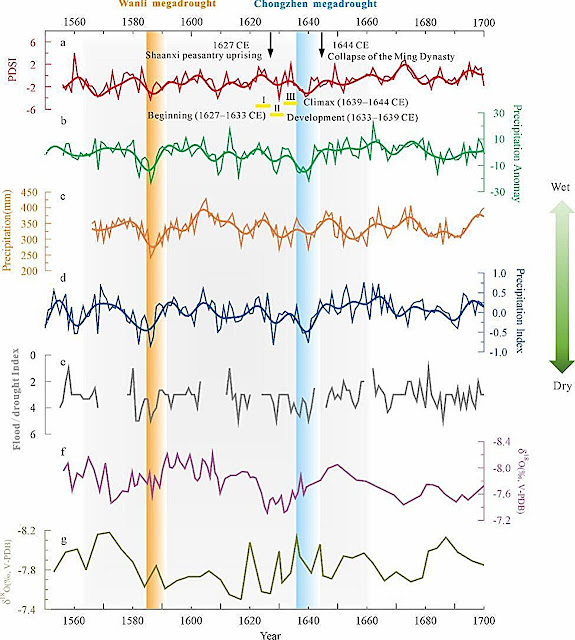Credit: Palaeogeography, Palaeoclimatology, Palaeoecology (2024). DOI: 10.1016/j.palaeo.2024.112548
Most previous studies on the collapse of the Ming Dynasty have focused on the famous "Chongzhen Drought" of the late Ming Dynasty, considering it an important factor in the decline of the Ming Dynasty. But insufficiency of data resolution and dating precision has limited our comprehensive understanding of the intrinsic relationship between the decline of the Ming Dynasty and climate change.
Now, a research team led by the Institute of Earth Environment (IEE) of the Chinese Academy of Sciences reconstructed the historical variations of the Palmer Drought Severity Index for July–September based on tree-ring stable oxygen isotopes (δ18O) from 1556 CE to 2015 CE in the southwest Chinese Loess Plateau.
The study is published in the journal Palaeogeography, Palaeoclimatology, Palaeoecology.
Enhancing the comprehension of the interaction mechanism between climate change and civilization development can offer valuable historical insights for humanity to address the challenges posed by global change.
"Hydroclimatic fluctuations are of paramount importance in the historical changes of China," said Professor Ren Meng from IEE, first author of the study.
The researchers revealed a significant weakening of the Asian summer monsoon between 1561 CE and 1661 CE, consistent with the Late Ming Weak Monsoon Period (1580–1660 CE), and analyzed the specific characteristics of this climatic anomaly in detail.
The reconstruction also captured a distinct humidification trend over northwest China since the 2000s, which coincides with the general trend of a warm-humid climate in northwest China.
In addition to the well-known Chongzhen megadrought, this study recorded the severe Wanli megdrought (1585–1590 CE) during the late Ming Dynasty, an event that rarely featured in earlier studies, exhibiting comparable duration and severity to the Chongzhen megadrought.
Further analysis indicated that the Wanli megadrought may have served as an early trigger for the collapse of the Ming Dynasty.
"Our analysis implicates the ENSO as a contributing factor in both the Wanli and Chongzhen megadroughts, and thus to the ultimate collapse of the Ming Dynasty by affecting the Asian summer monsoon intensity," said Professor Ren.
Recommend this post and follow
The Life of Earth


No comments:
Post a Comment
Stick to the subject, NO religion, or Party politics